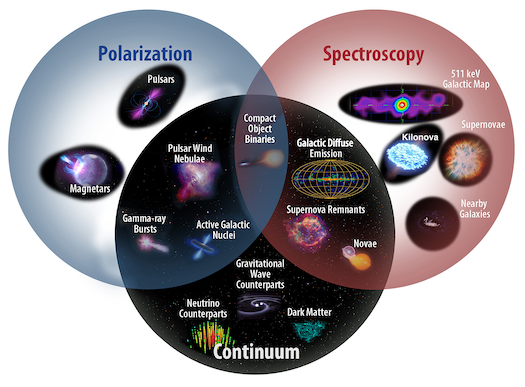MeV Gamma-ray Astronomy in the 2020s and Beyond
Splinter Meeting at the 241st Meeting of the American Astronomical Society.
Tuesday, January 10, 2023 from 2:00 - 3:30 PM (Pacific Time)
Location: Seattle Convention Center, Room 304, Seattle, WA
Henrike Fleischhack (fleischhack AT cua.edu) and John Tomsick (jtomsick AT berkeley.edu)
The session will be streamed on WebEx, password: 6shJeFp2Et8. Please click through for detailed connection information.
 MeV gamma rays offer a unique view of the extreme universe, from nuclear lines tracing supernova explosions to broadband emission from energetic particles accelerated in gamma-ray bursts, AGN jets, pulsars, and more. Gamma-ray instruments have played a key role in recent TDAMM (time-domain and multi-messenger) astronomy discoveries. We are at the cusp of a new era in MeV gamma-ray astronomy, with several missions planned to launch in the next few years and more under development. As a community, we must prepare for the new data to come and consider our strategy for MeV gamma-ray astronomy beyond the 2020s. In this session, we will hear updates from the missions currently under development. We will discuss which questions can be answered with these missions, and what other MeV gamma-ray capabilities might be needed in the future.
MeV gamma rays offer a unique view of the extreme universe, from nuclear lines tracing supernova explosions to broadband emission from energetic particles accelerated in gamma-ray bursts, AGN jets, pulsars, and more. Gamma-ray instruments have played a key role in recent TDAMM (time-domain and multi-messenger) astronomy discoveries. We are at the cusp of a new era in MeV gamma-ray astronomy, with several missions planned to launch in the next few years and more under development. As a community, we must prepare for the new data to come and consider our strategy for MeV gamma-ray astronomy beyond the 2020s. In this session, we will hear updates from the missions currently under development. We will discuss which questions can be answered with these missions, and what other MeV gamma-ray capabilities might be needed in the future.
Speakers, Topics, & Abstracts:
- Current and Future NASA Missions Focusing on GRBs
- Josh Wood (NASA MSFC)
- Current and Future European Missions Focusing on GRBs
- Rachel Dunwoody (UCD)
- The Compton Spectrometer and Imager
- Steve Boggs (UCSD)
- Gamma-ray Diagnostics of Explosive Transients
- Eric Burns (LSU)
- Science and Detection Prospects of Line Emission in the MeV Regime
- Carolyn Kierans (NASA GSFC)
- Science and Detection Prospects of Extra-Galactic MeV Gamma-Ray Source
- Marco Ajello (Clemson University)

